Hey, I'm Famous
Anyway:
Old Country Gardens
Makes me feel like I ought to do some blog posting of my own.
What a concept.
Because dirt under your fingernails is a GOOD thing
 Upon entering the hall, we were greeted by the Floratopia Tree, a large sculpture filled with flowers and plants of every description. Think Rose Bowl Parade float and you’re starting to get the picture. When we looked passed the tree, we could see the exhibits extending off in every direction. Every where you looked there was… wait for it… Rich Planty Goodness. At this point our crew split up to explore the hall individually.
Upon entering the hall, we were greeted by the Floratopia Tree, a large sculpture filled with flowers and plants of every description. Think Rose Bowl Parade float and you’re starting to get the picture. When we looked passed the tree, we could see the exhibits extending off in every direction. Every where you looked there was… wait for it… Rich Planty Goodness. At this point our crew split up to explore the hall individually.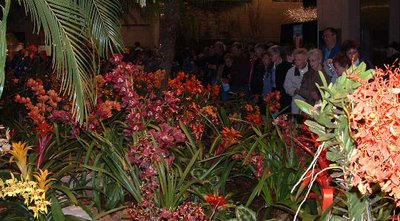 Waldor Orchids had a massive display of color-matched orchids that looked beautiful – they must have had thousands – but there was little botanical information, and the notorious difficulty of re-blooming orchids, I felt there wasn’t much to learn there.
Waldor Orchids had a massive display of color-matched orchids that looked beautiful – they must have had thousands – but there was little botanical information, and the notorious difficulty of re-blooming orchids, I felt there wasn’t much to learn there. J. Franklin Styer was involved in two displays that were very nice but flawed. The “Natura” exhibit was massively scaled sculpture of a goddess/nymph/dryad/whatever, raising out of a mountain, with a tree in one hand and a waterfall in the other. Regrettably, there were individual scenes around her base, all of which seemed to center on flower arrangements… I was quite taken, however, by a small section of the garden, that featured a carpet of pine, which I eventually figured out was dozens of Mugo Pines (Pinus mugo – Pinaceae) all squished together. The second exhibit by Styer was a beautiful woodland walk-through, one of the most naturalistic and convincing gardens in the show. The display featured a wide variety of mature nursery stock, including adult trees and numerous perennials forced into bloom. The garden over all was well-lit, well-labeled, and well laid-out. Unfortunately, it was also well-covered with atrocious fake snow that prevented proper appreciation of the plants.
J. Franklin Styer was involved in two displays that were very nice but flawed. The “Natura” exhibit was massively scaled sculpture of a goddess/nymph/dryad/whatever, raising out of a mountain, with a tree in one hand and a waterfall in the other. Regrettably, there were individual scenes around her base, all of which seemed to center on flower arrangements… I was quite taken, however, by a small section of the garden, that featured a carpet of pine, which I eventually figured out was dozens of Mugo Pines (Pinus mugo – Pinaceae) all squished together. The second exhibit by Styer was a beautiful woodland walk-through, one of the most naturalistic and convincing gardens in the show. The display featured a wide variety of mature nursery stock, including adult trees and numerous perennials forced into bloom. The garden over all was well-lit, well-labeled, and well laid-out. Unfortunately, it was also well-covered with atrocious fake snow that prevented proper appreciation of the plants. Fortunately, there were other impressive displays to look at. Rosade Bonsai Studio had an entire miniature landscape made up of bonsai specimens. I was most taken with a grove planting of Chamaecyparis obtusa (Cupressaceae). I was, however, frustrated by the lack of information commonly given for individual specimens, such as age and length of traing. For that reason I greatly preferred the Bonsai displayed by the Pennsylvania Bonsai Society. They had fewer specimens, but far more info. You could also get much closer to each tree, and better appreciate the minute details. I was most impressed by a Scotch Pine (Pinus sylvestris – Pinaceae) that was 45 years old. I also saw a style I wasn’t familiar with called “Literati” where all the normal bonsai rules go out the window. The Literati style features a long slender trunk that is usually angled, and just a few branches. The example they displayed was a Juniperus chinensis (Cupressaceae).
Fortunately, there were other impressive displays to look at. Rosade Bonsai Studio had an entire miniature landscape made up of bonsai specimens. I was most taken with a grove planting of Chamaecyparis obtusa (Cupressaceae). I was, however, frustrated by the lack of information commonly given for individual specimens, such as age and length of traing. For that reason I greatly preferred the Bonsai displayed by the Pennsylvania Bonsai Society. They had fewer specimens, but far more info. You could also get much closer to each tree, and better appreciate the minute details. I was most impressed by a Scotch Pine (Pinus sylvestris – Pinaceae) that was 45 years old. I also saw a style I wasn’t familiar with called “Literati” where all the normal bonsai rules go out the window. The Literati style features a long slender trunk that is usually angled, and just a few branches. The example they displayed was a Juniperus chinensis (Cupressaceae). A number of groups had displays that were overtly educational. The EPA (I don’t know why, but yeah, the EPA) had a great garden set up that was packed with native plants. I of course was drawn to a merger of two of my interests – two hypertufa troughs planted with Purple and Red Pitcher plants (Sarracenia purpurea, S. rubra – Sarraceniaceae). Delaware Valley College had a display called “Pioneers of Penn’s Woods” featuring detailed histories of early plantsmen. Among the many were Asa Gray, the first professor of botany at Harbard, Carl Linneaus, the father of the modern plant taxonomy, and Nathaniel Ward – the creator of the Wardian Case. Temple University had a walk-through garden featuring medicinal plants with informative handouts. The Williamson Free School did something similar with shoreline environments. The Delaware Valley Chapter of NARGS had a nice trough display with some new uses of hypertufa, including a large bowling ball like sphere with planting pockets formed all over its surface. In another trough, hypertufa spheres were used in place of rocks on the surface. I also really liked the look of three oval pans of different sizes that were stacked. An added pleasure at their display was meeting up with one of the women manning the display that I knew from Mason-Dixon Chapter meetings. She’s an older lady who has been doing alpines for a long time and has many photos in books by Rex Murfitt. Upon learning that I was now an intern at Stonecrop, she and another member said “Oh, you’re one of the lucky few!” I couldn’t agree more…
The Delaware Valley Chapter of NARGS had a nice trough display with some new uses of hypertufa, including a large bowling ball like sphere with planting pockets formed all over its surface. In another trough, hypertufa spheres were used in place of rocks on the surface. I also really liked the look of three oval pans of different sizes that were stacked. An added pleasure at their display was meeting up with one of the women manning the display that I knew from Mason-Dixon Chapter meetings. She’s an older lady who has been doing alpines for a long time and has many photos in books by Rex Murfitt. Upon learning that I was now an intern at Stonecrop, she and another member said “Oh, you’re one of the lucky few!” I couldn’t agree more… There were a number of displays that didn’t necessarily excite me over all, but had fantastic specimens. Burke Brothers had a Euphorbia lacteal ‘Cristata’ (Euphorbaceae) that was so well tucked into the surrounding foliage that I didn’t notice it till the third time I looked at it. Daniel Kepich & Associates had a great collection of azaleas that were at the peak of bloom, but my favorite was the stunning Rhododendron kurume ‘Blauuw’s Pink’ (Ericaceae). Garden Delights had many wonderful specimen succulents. They had massive versions of three houseplants of mine, Haworthia fasciata (Asphodelaceae), Opuntia rufida minima (Cactaceae) and the biggest Pachypodium geayi (Apocynaceae) I have ever seen.
There were a number of displays that didn’t necessarily excite me over all, but had fantastic specimens. Burke Brothers had a Euphorbia lacteal ‘Cristata’ (Euphorbaceae) that was so well tucked into the surrounding foliage that I didn’t notice it till the third time I looked at it. Daniel Kepich & Associates had a great collection of azaleas that were at the peak of bloom, but my favorite was the stunning Rhododendron kurume ‘Blauuw’s Pink’ (Ericaceae). Garden Delights had many wonderful specimen succulents. They had massive versions of three houseplants of mine, Haworthia fasciata (Asphodelaceae), Opuntia rufida minima (Cactaceae) and the biggest Pachypodium geayi (Apocynaceae) I have ever seen.
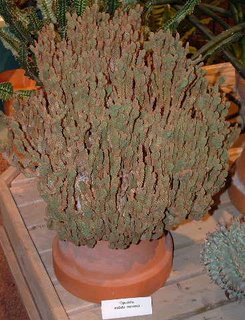
Opuntia rufida minima (Cactaceae)
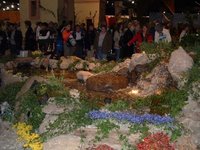 Perhaps the best combination of specimens, landscape, and information was compliments of Jacques Amand Bulb Specialists. They had a lovely little walk-through garden with a naturalistic design and two artful water features. The individual highlights were a mass planting of various Arisaema (Araceae), the stunning yellow and red fringed petals of Tulipa ‘Estella Rijneld’ (Liliaceae), Crocus ‘Zwanenburg Bronze’, and three dwarf Iris, Iris reticulata ‘Cantab’, I. reticulata ‘Marguerite’ and Iris ‘Danforidae’ (Iridaceae).
Perhaps the best combination of specimens, landscape, and information was compliments of Jacques Amand Bulb Specialists. They had a lovely little walk-through garden with a naturalistic design and two artful water features. The individual highlights were a mass planting of various Arisaema (Araceae), the stunning yellow and red fringed petals of Tulipa ‘Estella Rijneld’ (Liliaceae), Crocus ‘Zwanenburg Bronze’, and three dwarf Iris, Iris reticulata ‘Cantab’, I. reticulata ‘Marguerite’ and Iris ‘Danforidae’ (Iridaceae).
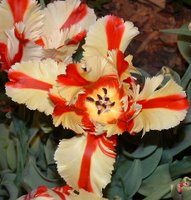 Tulipa ‘Estella Rijneld’ (Liliaceae)
Tulipa ‘Estella Rijneld’ (Liliaceae)

Crocus ‘Zwanenburg Bronze’ (Iridaceae)
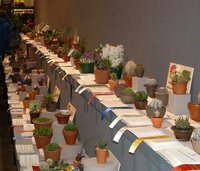 Something exciting at the Philadelphia show that was absent from my experiences with the Maryland Home and Garden show was the presence of competitively judged plants. There were hundreds of beautiful specimens of bulbs, succulents, dish gardens, topiaries, foliage plants… the list goes on.
Something exciting at the Philadelphia show that was absent from my experiences with the Maryland Home and Garden show was the presence of competitively judged plants. There were hundreds of beautiful specimens of bulbs, succulents, dish gardens, topiaries, foliage plants… the list goes on. Conophytum obcordellum (Aizoaceae)
Conophytum obcordellum (Aizoaceae)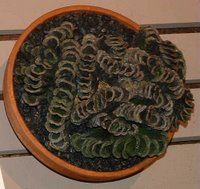 Haworthia truncata (Asphodelaceae)
Haworthia truncata (Asphodelaceae) There were a number of flowers I quite liked. Scilla mischteschenkoana (Liliaceae) had big clumps of beautiful white flowers. I also liked tiny Primula allionii ‘Anna Griffith’, Tulipa ‘Coleur Cardinal’ (Liliaceae) and the orchid-like markings on Iris ‘Katharine Hodgkin’ (Iridaceae). Great foliage plants included tiny, ten-year old Abies balsamea ‘Jami’ (Pinaceae), Trillium underwoodii (Trilliaceae), Dasylirion longissumum (Agavaceae) and the spiral foliage of Beaucarnea recurvata (Agavaceae).
There were a number of flowers I quite liked. Scilla mischteschenkoana (Liliaceae) had big clumps of beautiful white flowers. I also liked tiny Primula allionii ‘Anna Griffith’, Tulipa ‘Coleur Cardinal’ (Liliaceae) and the orchid-like markings on Iris ‘Katharine Hodgkin’ (Iridaceae). Great foliage plants included tiny, ten-year old Abies balsamea ‘Jami’ (Pinaceae), Trillium underwoodii (Trilliaceae), Dasylirion longissumum (Agavaceae) and the spiral foliage of Beaucarnea recurvata (Agavaceae).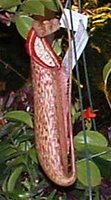 At last we came to the instant gratification part of the show… blowing our hard-earned cash at the many sales booths. I was wowed by the overwhelming numbers and variety of plants for sale. While I was very tempted by the tropical pitcher plant Nepenthes x Miranda (Nepenthaceae), I managed to escape with less than $40 in purchases (Didn’t I just get finished giving all my plants away?!?), spending it at Meehan’s Miniatures (a MD bonsai company) and Desertlands – succulent specialists. Martha sold me three tiny bonsai pots, Scirpus cirnuus (Cyperaceae), Selaginella emmeliana (Sellaginaceae), Crassula portulaceae (Crassulaceae) and Sagina subulata (Caryophyllaceae). Desertlands sold me three tiny succulents that I have not yet conclusively identified and a very cool Euphorbia obesa (Euphorbaceae) – aka Baseball plant.
At last we came to the instant gratification part of the show… blowing our hard-earned cash at the many sales booths. I was wowed by the overwhelming numbers and variety of plants for sale. While I was very tempted by the tropical pitcher plant Nepenthes x Miranda (Nepenthaceae), I managed to escape with less than $40 in purchases (Didn’t I just get finished giving all my plants away?!?), spending it at Meehan’s Miniatures (a MD bonsai company) and Desertlands – succulent specialists. Martha sold me three tiny bonsai pots, Scirpus cirnuus (Cyperaceae), Selaginella emmeliana (Sellaginaceae), Crassula portulaceae (Crassulaceae) and Sagina subulata (Caryophyllaceae). Desertlands sold me three tiny succulents that I have not yet conclusively identified and a very cool Euphorbia obesa (Euphorbaceae) – aka Baseball plant. 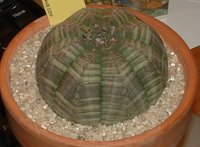
Euphorbia obesa (Euphorbaceae)
After a long day it was time to grab some more comfort food from Reading Market, and pack into the car for a game of “Capability Brown” on the way back to Stonecrop. Overall, it was a great experience. While I was at first a bit disappointed by the show (due to unrealistically high expectations – I had always been told the Philly show was 10 times better than the MD show – it’s only twice as good), I quickly fell under it’s spell and had a great time. While I would have liked to see more displays with an emphasis on practical and realistic landscapes, and fewer with exploding mudpot geysers, fake snow and inexplicably, dryer vents, I was blown away by the number and quality of specimen plants being judged, displayed, and sold. I’ll definitely go again in the future, and recommend that you check it out if you ever get the chance.
Wow. Longest post I’ve ever done*. Stay tuned, there will be more field trips, more sights of Stonecrop, and I will probably begin featuring some of my Plants of the Day.
*Full Disclosure: This post is, in fact, adapted from the essay I wrote for Stonecrop about the field trip. The post is a little more fluffy, the essay was a bit “heavy on the sausage”, to use Caroline’s expression. Does it still qualify as longest post ever?


Into this: 
close up here: 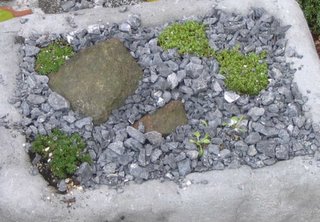
featuring Phlox subulata, Silene acaulis 'Mt Snowdon', and some other stuff I can't remember at the moment.
It also turned into this:
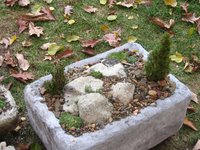 I really really like the way this large trough came out. It's big enough that I think the dwarf conifer that's in there will be able to thrive - and it's height adds a bit of drama that is missing from most of my troughs. The boulder in the middle was a perfect specimen I pulled from the woods. It had nice fractures breaking it into four pieces, but they were still intact and adjacent. Each section of the rock is also covered with lichen, which immediately adds an air of age to the planting. And I was able to use the crevices between the rock sections to plant two species of Draba - an ideal environment for them. The gravel mulch is sifted from the stream behind the house, so it matches the native bedrock quite nicely.
I really really like the way this large trough came out. It's big enough that I think the dwarf conifer that's in there will be able to thrive - and it's height adds a bit of drama that is missing from most of my troughs. The boulder in the middle was a perfect specimen I pulled from the woods. It had nice fractures breaking it into four pieces, but they were still intact and adjacent. Each section of the rock is also covered with lichen, which immediately adds an air of age to the planting. And I was able to use the crevices between the rock sections to plant two species of Draba - an ideal environment for them. The gravel mulch is sifted from the stream behind the house, so it matches the native bedrock quite nicely.
Here is a closer view of this trough:

The plants growing in the boulder crevices are Draba rigida
(lower left) and Draba cretica (upper right). The other plants include (clockwise from the upper left corner) a dwarf Alberta Spruce (Picea glauca 'Jean's Dilly'), One I can't remember, Euonymous japonica 'Rokujo', Armeria 'Victor Reiter', and Dianthus gratianopolitanus 'Sternkissen'.Now all I need is about fifteen more troughs, and none of my plants will have to live in pots and on benches and in sand beds.
Next gardening task is more leaf removal and sifting some more gravel to top off a few of the troughs who need it.

Interesting garden activities of late. It is early-mid november, and we have been having lots of lovely, sunny 60-80 degree days the last few weeks. It's not quite an Indian Summer (no hard frost yet) but it has made for some amazing walks in the woods. But it is also messing with the heads of a few of my plants.
 The roses are blooming like crazy, and I hoping most of the existing buds get a chance to open before the frost does them in. There are a good dozen or so buds in various states of flower, on top of the dozen or so I cut last weekend that were at their peak to give to the girl... Does it count against me that my first thought was "I should cut these before the frost kills them -- I know, I'll give them to the girl" and not "These are beautiful. I should cut them and give them to the girl, who is also beautiful"?
The roses are blooming like crazy, and I hoping most of the existing buds get a chance to open before the frost does them in. There are a good dozen or so buds in various states of flower, on top of the dozen or so I cut last weekend that were at their peak to give to the girl... Does it count against me that my first thought was "I should cut these before the frost kills them -- I know, I'll give them to the girl" and not "These are beautiful. I should cut them and give them to the girl, who is also beautiful"?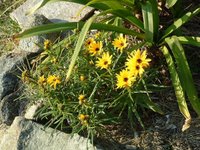 Then there is my dwarf swamp sunflower (Helianthus 'Low Down'). I got it back in may, a little worse for wear, but still healthy and vigorous. Maybe I put it in the ground too late in the spring, but that little bugger didn't do a damn thing all summer (you know, when sunflowers are supposed to be blooming). But it budded out about three weeks ago, and there are actually a number of the flowers that have managed to open in the last week or so - it's not super-impressive, but it gives a good indication of what I may be treated with in the coming years (unlike it's better known cousins, this sunflower is a perennial). This is definitely one of the few plants I put in the ground that I will dig up and take with me if I move out.
Then there is my dwarf swamp sunflower (Helianthus 'Low Down'). I got it back in may, a little worse for wear, but still healthy and vigorous. Maybe I put it in the ground too late in the spring, but that little bugger didn't do a damn thing all summer (you know, when sunflowers are supposed to be blooming). But it budded out about three weeks ago, and there are actually a number of the flowers that have managed to open in the last week or so - it's not super-impressive, but it gives a good indication of what I may be treated with in the coming years (unlike it's better known cousins, this sunflower is a perennial). This is definitely one of the few plants I put in the ground that I will dig up and take with me if I move out. I have also finished two more troughs - both of the grout-over styrofoam type, rather than manufactured from hypertufa. The larger of the two is the 2nd biggest I've ever made. I only did it after I saw a great big styrofoam cooler sitting in the middle of the road on the way to my house. I'd never seen a styrofoam box that big before. I got to it just as a cop stopped in the middle of the road to move it - when I came over to him, he asked if it was mine. I said "no, but I was going to take it anyway". He didn't seem to mind. It was, after all, a piece of trash.
I have also finished two more troughs - both of the grout-over styrofoam type, rather than manufactured from hypertufa. The larger of the two is the 2nd biggest I've ever made. I only did it after I saw a great big styrofoam cooler sitting in the middle of the road on the way to my house. I'd never seen a styrofoam box that big before. I got to it just as a cop stopped in the middle of the road to move it - when I came over to him, he asked if it was mine. I said "no, but I was going to take it anyway". He didn't seem to mind. It was, after all, a piece of trash.
I'm very much looking forward to planting them up (hopefully this weekend). I would have at least partially planted them this past weekend, but I realized that I have quite a stockpile of trough-worthy plants, but I hadn't thought which ones go well together. So I made a list of all the available plants and their cultural requirements - just to make sure I don't end up sticking a shade-lover with a sunny drought-tolerant plant. Sadly, I've made such mistakes a number of times in the last few years.
 One trough I didn't screw up is one that I replanted this past weekend - it's previous occupants died a sad death this summer - four silver saxifrages that just couldn't take our Mid-Atlantic heat and humidity. So in the place of the saxes are Dwarf Arctic Birch (Betula nana), Corsican Mint (Menthus requienii), and Bluets, aka Quaker Ladies (Housitonia caerulea) . All of them like a nice moist soil, and will hopefully do well in the shadow of my whiskey barrel pond - absorbing all of it's overflow.
One trough I didn't screw up is one that I replanted this past weekend - it's previous occupants died a sad death this summer - four silver saxifrages that just couldn't take our Mid-Atlantic heat and humidity. So in the place of the saxes are Dwarf Arctic Birch (Betula nana), Corsican Mint (Menthus requienii), and Bluets, aka Quaker Ladies (Housitonia caerulea) . All of them like a nice moist soil, and will hopefully do well in the shadow of my whiskey barrel pond - absorbing all of it's overflow.
Of course, what I should really be doing is working on my application to Stonecrop (it came in the mail last Friday). But that's another story entirely...